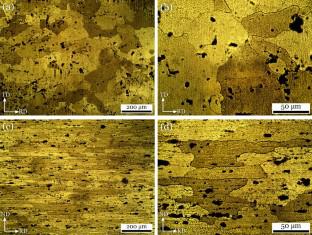Archives of Civil and Mechanical Engineering ( IF 4.4 ) Pub Date : 2022-10-23 , DOI: 10.1007/s43452-022-00553-y Mohammad Reza Roodgari , Roohollah Jamaati

|
In the current study, the microstructure and mechanical properties of AA2024 alloy produced by a new technique consisting of solution treatment, instantly followed by asymmetric cold rolling with a reduction of 65%, and subsequent artificial aging (heat treatment) with four temperatures of 190, 300, 400, and 500 °C was investigated. The additional shear strain in asymmetric rolling led to the formation of a high amount of shear bands in the microstructure of AA2024 alloy. During aging treatment at the temperature of 300 °C, recrystallization was locally started in the shear bands. The grain morphology of the rolled sample was not much changed after aging at the temperature of 190 and 300 °C. However, the samples aged at 400 and heat-treated at 500 °C had different microstructures. In addition, with increasing the temperature to 500 °C, numerous dispersoids were formed in the microstructure of the AA2024 alloy. The sample after aging treatment at 190 °C had the maximum hardness, yield strength, and ultimate tensile strength of 207.4 HV, 481.7 MPa, and 605.1 MPa, respectively, along with a desirable elongation (7.9%). By increasing the aging temperature, the hardness and strength of the alloy considerably decreased. The aging treatment at 400 and heat treatment at 500 °C led to the complete elimination of the strain hardening effect and recurrence of Portevin–Le Chatelier (PLC) in the stress–strain curves. The fracture mode was often a ductile mode for all samples. By increasing the aging temperature, the number and size of dimples increased. As a consequence, the processing technique used in the present study resulted in an excellent strength-ductility balance due to an appropriate combination of strain hardening and precipitation hardening.
中文翻译:

一种在 AA2024 合金中实现优异强度-延展性平衡的技术
在目前的研究中,采用一种新技术生产的AA2024合金的显微组织和力学性能包括固溶处理,紧接着是压下量为65%的不对称冷轧,随后是190°的四个温度的人工时效(热处理),研究了 300、400 和 500 °C。不对称轧制中的附加剪切应变导致AA2024合金微观结构中形成大量剪切带。在 300 ℃时效处理过程中,剪切带局部开始再结晶。轧制试样的晶粒形貌在 190 和 300 ℃时效后变化不大。然而,在 400 ℃时效和在 500 ℃热处理的样品具有不同的微观结构。此外,随着温度升高到 500 °C,在 AA2024 合金的微观结构中形成了许多弥散体。在 190 °C 时效处理后的样品的最大硬度、屈服强度和极限抗拉强度分别为 207.4 HV、481.7 MPa 和 605.1 MPa,以及理想的伸长率 (7.9%)。通过提高时效温度,合金的硬度和强度显着降低。400℃时效处理和500℃热处理导致应变硬化效应完全消除,Portevin-Le Chatelier (PLC) 在应力-应变曲线中再次出现。断裂模式通常是所有样品的延展模式。通过提高时效温度,凹坑的数量和尺寸增加。作为结果,











































 京公网安备 11010802027423号
京公网安备 11010802027423号